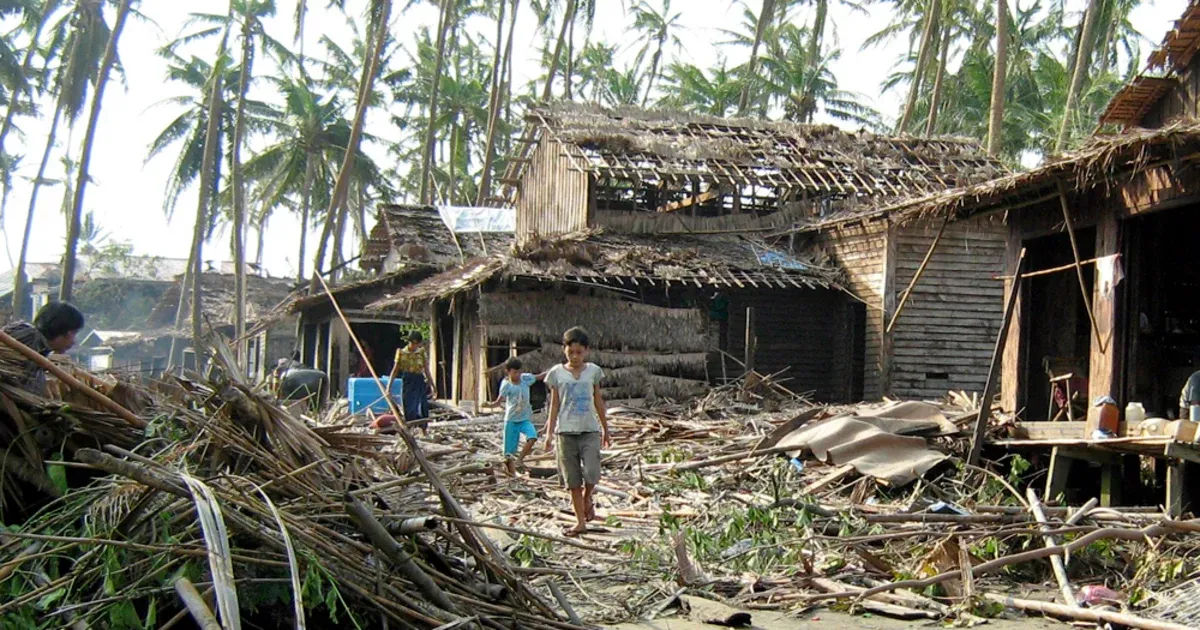Recounting the Impact of the Cyclone on Myanmar
Myanmar has been no stranger to the formidable storms that originate in the Bay of Bengal.

Introduction
Nature's capriciousness can manifest in various forms, often reminding us of its supremacy through catastrophic events. Myanmar, a country of diverse landscapes and rich cultural heritage, has experienced its fair share of natural disasters. Among these, cyclones stand out as one of the most formidable forces of destruction. we explore the harrowing impact of cyclones on Myanmar, the challenges faced by its resilient people, and the collective efforts to rebuild and prepare for an uncertain future.
A Historical Perspective
Myanmar has been no stranger to the formidable storms that originate in the Bay of Bengal. The nation experiences the impact of potent storms approximately every 1 to 2 years, with an average of about 5 cyclones occurring annually. Regions like Rakhine, Chin, and Ayeyarwady often bear the brunt of these natural forces. The cyclone season, closely tied to the summer monsoon, witnesses the most intense storms in the months leading up to (May to June) and following (October to November) this period.

One of the most catastrophic cyclones etched in Myanmar's history is Cyclone Nargis, which struck in 2008. As a powerful category 4 storm, it targeted the usually sheltered Irrawaddy Delta, subjecting it to fierce winds and a 12-foot storm surge. The aftermath was devastating, affecting millions, claiming the lives of 140,000 individuals, and displacing around 800,000. Another recent impactful event was Cyclone Mocha, emerging as one of Myanmar's strongest storms. Making landfall on a Sunday, this cyclone tragically claimed at least 40 lives, leaving behind a trail of destruction.
Devastation and Aftermath
The unrelenting might of a cyclone unfurls a path of utter devastation in its wake. Its fierce winds, accompanied by torrential rains and surging ocean waters, join forces to dismantle critical infrastructure, submerge arable lands, and uproot countless lives. The toll is particularly profound in countries like Myanmar, where the livelihoods of many are intricately tied to agriculture. The loss of crops and livestock can thrust families into dire straits, exacerbating an already precarious situation. The destruction is all-encompassing—homes are razed, once-passable roads lie in ruins, and the basic necessities of clean water and healthcare become distant luxuries.
Yet, the toll exacted by cyclones goes beyond the tangible destruction. The psychological scars left in their wake are equally profound. Communities grapple with the trauma of losing loved ones, cherished homes, and the very foundation of security. The forced displacement often shunts people into temporary shelters, where the battle for even the most fundamental requirements compounds their already fragile predicament. As the physical and emotional aftershocks reverberate, affected populations strive to piece together shattered lives while grappling with the enormity of the challenges that lie ahead.
Unity and Recovery
Myanmar's adept handling of cyclone aftermaths stands as a testament to its unwavering resolve and solidarity during times of adversity. Promptly in the wake of these calamities, the government, with the collaboration of humanitarian entities and global allies, orchestrates a rapid and coordinated response. Swiftly activated, this response apparatus channels vital emergency aid to impacted regions. Basic essentials—food, water, shelter, and medical care—are extended to afflicted communities, emerging as beacons of hope amid the turmoil.

However, the embodiment of true resilience transcends the realm of immediate relief efforts. It involves the formulation of meticulous, long-term strategies encompassing preparation, community participation, and infrastructure enhancement. Within these strategies lie the bedrock of disaster management—a network of early warning systems, educational initiatives on disaster preparedness, and the reinforcement of essential infrastructure. With a forward-looking perspective rooted in the lessons gleaned from prior encounters with nature's fury, Myanmar endeavors to bolster its disaster management protocols. These fortified measures are designed to foster a more efficient, effective response in the face of future cyclones, underscoring the nation's commitment to safeguarding its populace against nature's unpredictable onslaughts.
Adapting for a Resilient Future
Renowned for its exceptional biodiversity and natural resources, Myanmar finds itself positioned as one of the world's most vulnerable nations to the far-reaching repercussions of climate change. This vulnerability is reflected in the escalating frequency and intensity of floods, cyclones, and droughts, wreaking havoc on lives, infrastructure, and the economy1. In the face of these challenges, Myanmar's capacity to respond is notably weaker than that of its regional counterparts1.
Engaging proactively, the United Nations Environment Programme (UNEP) has actively contributed to a project aimed at integrating climate change adaptation and mitigation into Myanmar's national policies. An illustrative example is the Myanmar Climate Change Alliance program, operational from 2013 to 2019. This initiative was conceived to raise awareness regarding climate change impacts, bolster the capabilities of government officials in addressing these impacts, and formulate and implement localized strategies to identify and tackle vulnerabilities arising from climate change.
New policy directives under development explicitly acknowledge the mounting menace posed by extreme weather events and other climate change consequences to Myanmar's socio-economic advancement. These policies outline an ambitious vision—transforming Myanmar into a resilient, low-carbon society, characterized by sustainability, prosperity, and inclusivity1. Looking forward, Myanmar is presented with four pivotal opportunities for adaptation. These comprise heightening awareness about the imperative of embedding climate change considerations into daily governance processes, augmenting local initiatives to enhance climate resilience and disaster preparedness, fostering the evolution of a comprehensive climate change strategy, and framing a policy framework to steer these efforts towards a climate-resilient future.
FAQs
What are the effects of the cyclone in Myanmar?
The cost of direct damage to buildings, infrastructure, and agriculture from Cyclone Mocha is estimated at $2.24 billion.
How often do cyclones occur in Myanmar?
Cyclones only occur occasionally in Myanmar. On average, they happen about 5 times a year.
Are cyclones common in Myanmar?
Myanmar normally experiences cyclones between mid-April and mid-May, and during October and November.
Conclusion
Cyclones in Myanmar serve as poignant reminders of the fragility of human existence in the face of nature's might. Yet, the unwavering spirit of its people, combined with concerted efforts by government bodies, non-governmental organizations, and the global community, offers a glimmer of hope. As Myanmar navigates the uncertain waters of climate change, it stands as a testament to human determination and resilience—a beacon of strength for a nation that refuses to be defeated by the forces of nature.




